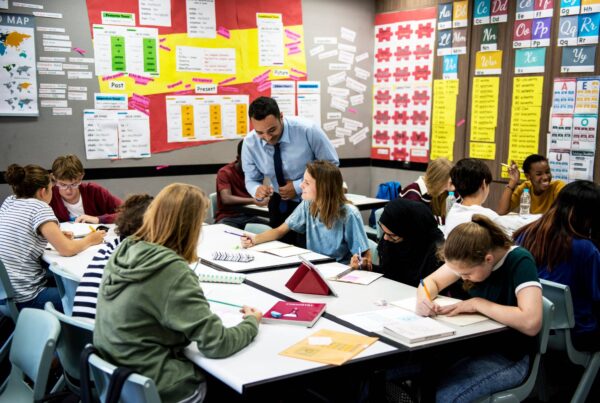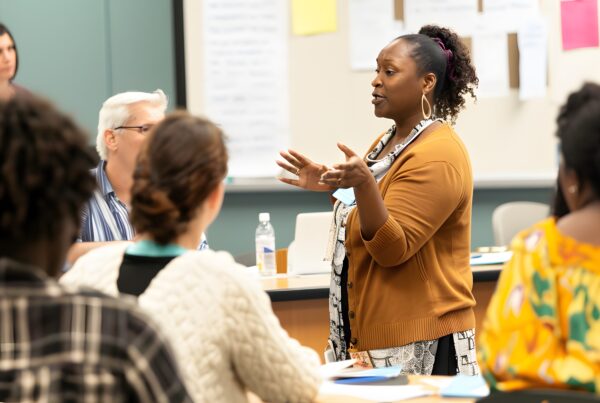“With the ever-changing landscape of education, teachers and leaders often find themselves searching for clarity in a sea of standards, curriculum resources, and competing priorities” (Almarode & Vandas 2018, p. 1)
In this time of expanded expectations and initiatives in schools, it can be challenging to establish and maintain clarity and focus. Taking the time to get clear on professional learning and growth can make all the difference.
It has long been demonstrated that having clear learning targets and goals increases student achievement significantly. If that is true for students in our classrooms, doesn’t it make sense that it is also true for learners of any age? Increasing clarity is indeed a critical component in helping teachers (and leaders!) develop their knowledge and skills. In fact, it has been identified as one of the five critical conditions that must be in place in order to accomplish ongoing professional learning and growth. When asking teachers to continue to grow professionally, we need to provide and support that clarity for them.
| Five Critical Conditions for Increasing Teacher Expertise |
|
Table 1. Marzano, Frontier, & Livingston (2011, p. 4)
In previous articles of this series, we have explored the first three of these five critical conditions, and challenged you to assess your school or district’s current status in each. We provided ideas to assist in your next steps, and suggested resources to help move forward.
- Did you verify that your teachers, staff and administrators have a common language of instruction? Were you able to solidify their understanding of a shared model of instruction? As leaders, the task then is to continue to maintain focus on that model, to provide support around the constructs. If that common language does not seem to be solidly in place, refer to Condition 1: Supporting a Common Language of Instruction for resources and ideas to strengthen that critical area.
- When you gave feedback to teachers, was that feedback objective and focused and did the feedback remain centered in the model of instruction? If so, your ongoing task is to provide multiple opportunities for the teachers to show growth on those initial data points. If you identified this as an area of ongoing need, refer to Condition 2: Focused Feedback and Deliberate Practice to help you build your practice in this area.
- Did you implement, or increase opportunities for teachers to observe and discuss teaching and learning? When that practice is strong, leaders’ continuing role is to plan and support the sharing of ideas and expertise. In schools where these opportunities are still not a common part of teacher practice, Condition 3: Opportunities to Observe and Discuss Teaching and Learning will help leaders identify and plan supportive structures that build this type of learning culture.
Continuing the work on these Critical Conditions for Increasing Teacher Effectiveness, the next step is to dive deeper into the power of communicating Clear Criteria and a Plan for Success.
The Research Behind Clarity in Learning
Professor John Hattie coined the term “Visible Learning,” which highlights the importance of making the learning process transparent to students, so that they are more able to become successful self-regulated learners. This helps them develop the skills they need to become independent and lifelong learners. The same research can apply to adult learners.
Does your professional development integrate one of the key instructional techniques teachers are asked to implement in the classroom, Identifying Critical Content? As defined by Dr. Robert Marzano in his Focused Teacher Evaluation Model, this element requires teachers to identify and communicate to students the critical content of the lesson. The same concept can be applied to professional learning – learners must know their learning target , and the facilitator’s job is to maintain that clarity of focus. Research has clearly shown the positive impact that the use of this strategy provides.
| Identifying Critical Content |
| Focus Statement: Teacher uses the progression of standards-based learning targets (embedded within a performance scale) to identify accurate critical content during a lesson or part of a lesson. |
| Desired Effect: Evidence (formative data) demonstrates students know what content is important and what is not important as it relates to the learning target(s). |
Marzano Focused Teacher Evaluation Model 2017
Beginning with a Clear Idea of Your Destination
In his bestselling book, The Seven Habits of Highly Effective People (2004), author Stephen Covey identifies Habit 2: Begin with the End in Mind. As he says, “People are working harder than ever, but because they lack clarity and vision, they aren’t getting very far. They, in essence, are pushing a rope with all of their might” (p. 109). This is certainly true of teachers and school leaders, as they continue to work harder and harder, yet often feeling as if they are not even holding ground, but often as if they are falling farther and farther behind current expectations.
“To begin with the end in mind means to start with a clear understanding of your destination. It means to know where you’re going so that you better understand where you are now and so that the steps you take are always in the right direction, and so you recognize when you’ve arrived at success” (Covey 2004, p. 54).
How difficult is it to get somewhere when you don’t have a clear idea of the destination? Consider receiving a wedding invitation from a friend. You may be very excited to attend, happy for your friend, wanting to support them. Then, on the invitation, you read, “an afternoon in September in Ohio.” How do you make a roadmap or plug in a GPS location for that?
Teachers often feel that the professional development and feedback they get is like that less-than-helpful invitation. Teachers may say, “You want me to do better at classroom management,” or “My observation feedback said that I need to be more creative,” but they may not be clear on the destination that feedback is leading them toward. If teachers receive vague input like this on a regular basis, they may have a difficult time identifying how to “get there” and we may not see the increase in teacher effectiveness that we want.
The first step to improving your clarity and plan for success is to assess how your building is operating now in this critical condition. You can use the chart below.
If your self-assessment indicates that your building is “not there yet” in terms of having clarity around instructional expectations, read on for research-based tips.
| Clear Criteria and a Plan for Success:
How will you know when this condition is strong in your school?
|
|
Overcommunicate for Clarity
Consider author Patrick Lencioni’s work around organizational health. Lencioni posits that “Creating clarity is essential to building and maintaining a healthy organization,” (Lencioni 2012, p. 24). He stresses that communicating a goal or focus is not enough.
It’s often tempting to say, “I sent an email,” or “We just did that PD session,” when frustrated at people’s lack of understanding of the work we are asking them to do. However, research has established that people need to hear important information multiple times and in multiple ways in order to ensure that there is clarity and understanding.
In Lencioni’s model, clarity is the most important component in establishing organizational health. First, he says, establish your team. Then Create Clarity, Overcommunicate Clarity, and Reinforce Clarity.
What can you do in your teams to not only communicate, but overcommunicate and reinforce clarity? In the next section, we’ll cover the five steps to create a structure that supports multiple exposures to the information and skills you want your teachers to master, including multiple opportunities to monitor and assess understanding.
5 Steps to Promote Clarity
1 – Implement and support a clear and cohesive instructional model.
The Marzano Focused Evaluation Model is an objective, evidence-based model that evaluates teacher performance against specific criteria, alignment to standards, and student evidences. As you ensure the implementation of your instructional model, seek to ascertain teachers’ level of understanding, and “fill gaps” as needed.
2 – Unpack adult learning standards (i.e. FTEM elements) to clearly identify what teachers are expected to know and be able to do.
For each competency (element), FTEM incorporates a clear focus statement and desired effect, plus sample instructional techniques and strategies for evaluating student work. Use these protocols with teachers in multiple settings, not just during an observation/evaluation cycle. Have small groups of teachers in staff meetings, for instance, unpack the focus statement and desired effect of key elements and plan for how they will use those strategies in their upcoming lessons, including how they will monitor for the desired effect.
3 – Assist teachers to identify their current level of expertise on these elements, and the next logical step along a progression to mastery.
The focused model includes specific and clear protocols, as well as a developmental scale to provide teachers with clear criteria and a roadmap for success. The Growth Plan process within provides a self-assessment tool. Teacher self-reflection combined with observer and/or coach feedback assists teachers to identify a solid baseline. Combined with the specific and clear developmental scale for each element, the teacher can see what needs to be added to their practice for growth and eventual mastery of the strategy.
4 – Provide multiple exposures and opportunities to identify, practice and reflect on key instructional strategies.
In School Leadership for Results, Carbaugh and Marzano (2018) speak to this leadership skill in Domain 3, Element 3: “The school leader ensures that teachers and staff are provided with job-embedded professional development to optimize professional capacity and support their growth goals” (p. 84). The Focused Teacher Model supports the leader in this task by providing not only these specific protocols, but also access, through IE’s Observation tool, to tools and resources that support growing their practice, including text documents, videos, examples, and reports that allow the leader and the teacher to track their progress towards mastery. Along with specific, targeted professional development (avoiding “one size fits all” as much as possible), peer observations, and coaching, these tools help to accomplish the Desired Effect, which is “Teachers and staff improve their skills as a result of participating in professional development.”
Multiple exposures and opportunities for growth involves utilizing all resources to maximize results. Peers and coaches become the powerful tool that supports teacher learning. Provide the professional development in multiple venues and approaches, and then capitalize on your staff’s expertise to support teachers in practicing and mastering the skills presented.
The Marzano Evaluation Center supports districts across the country in these types of professional development opportunities, including virtual and onsite teacher and leader trainings, coaching, and consultation.
5 – MONITOR, MONITOR, MONITOR….
As a leader, just assuming your teachers “get it” will guarantee frustration and disappointment. Check for understanding through multiple data points, including not only short and long observations, but also discussions, surveys, and PLC collaborations. Use IE’s Observation tool to monitor and check for progress and discuss that progress with teachers. Empower PLC groups and coaches by helping them become familiar with IE’s Observation tool and the resources provided there as well as with how they can monitor their own progress using those tools (emphasize that it is NOT just something used by the leader in observation and evaluation cycles!). When recognizing a gap in understanding, follow up with additional resources and opportunities to practice. Match teachers with a peer or coach for all-important intervention and extension of learning.
Be the change! Reflect on your own professional development over time. Have you sometimes had to struggle to discover what was really expected of you? Were you sometimes clear about the “next steps” to lead you closer to mastery? What was the difference between those two experiences?
CLARITY results in maximizing growth and accomplishment. For most learners, whether they are age five or fifty, clarity – knowing what success looks like and what steps will lead there – is the critical difference between floundering and focus.
Take time now to identify your own next steps in creating and overcommunicating clarity for your staff.
References
Almarode, J.T. & Vandas, K.L. (2018). Clarity for Learning: Five Essential Practices That Empower Students and Teachers. Corwin.
Carbaugh, B. G., & Marzano, R. J. (2018). School leadership for results: A focused model.
Covey, S.R. (2004). The 7 Habits of Highly Effective People: Restoring the Character Ethic. Free Press.
Lencioni, P. M. (2012) The Advantage: Why Organizational Health Trumps Everything Else In Business. Jossey-Bass.
Marzano, R.J., Frontier, T., & Livingston, D. (2011) Effective Supervision: Supporting the Art and Science of Teaching. ASCD.
Marzano, R. J. (2005). School leadership that works: From research to results. ASCD
About The Author: Kathleen Marx
Kathleen Marx, MSEd, is a leading expert in personal development across industries. Ms. Marx has worked closely with Dr. Robert J. Marzano and the Marzano Evaluation Center team in developing content and training new staff developers. Her background in classroom teaching, gifted education consulting, school counseling, life-success facilitation, and school leadership give her unique insights into leading strategies in implementing research-based instructional and evaluation models. She earned her master’s degrees in educational leadership and school counseling from the University of Dayton.





